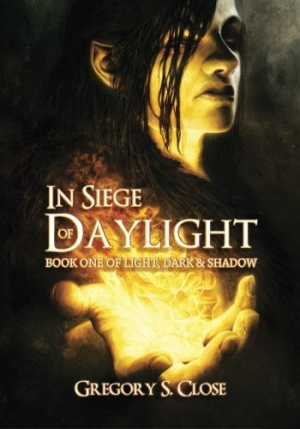In Siege of Daylight
Book One in the Compendium of Light, Dark & Shadow
It is no mean feat to craft a fantasy world that is different, familiar, interesting, and fresh. Gregory S. Close has done that and more with In Siege of Daylight: Book One in the Compendium of Light, Dark & Shadow, a weighty and daunting tome, but one worth delving into.
The author notes in his acknowledgments that he lived in Ireland for a time. So it is no surprise that the landscape, language, and literary tradition of the Gael have more than just seeped into Close’s writing. In Siege of Daylight is infused with Gaelic and Celtic sights and sounds, and not just because of the flood of tongue-curling names like Ilnymhorrim, Dieavaul, Calvraign, and Dwynleigsh (respectively, a sword, the villain, a hero, and a castle).
The very land of Providayne, in which the fantasy is set, drips with all things Irish, from the woodland magic of faeries to the prominence given to bards, around a pair of whom one of the three main threads of the story is woven. The other principal story lines involve a quest by a mercenary captain and his medical companion (a talking female “lizardman”), and a military campaign centered around one of the Raogmyztsanogg, or “dread forest watchers” (rangers in whose veins runs the blood of a magical folk who can command the trees and vines to fight). All three paths pit these heroes against the requisite evil wizard and his army of dringli, hrumm, and graomwrnokk warriors.
As with many evil dark lords in fantasy, this one wields a mighty magic device, a blade—but not just any blade. As one minor character warns, “The sword of the Guhddan-kinne does not simply send you beyond the Veil with a mortal blow! This blade cuts so deep it sunders the strings that hold your soul and binds you to ages of bloody torment at the service of the Dark God!” That mouthful is screeched by a character of whom Close, poking fun at himself as a writer and at the genre, notes, “as a priest, she had somehow managed to spit all that out in one breath with the proper inflection.”
The prose here is rich and lyrical. Yet when he gets too serious or pompous, Close is quick to take it all down a notch, such as when he has his otherwise gloriously noble ranger hero literally caught with his breeches down.
Close’s writing, however, is not perfect. The Gaelic and guttural names often confuse and overwhelm the eye and the ear. Many of his terms are not described, and he leaves it to the reader to puzzle out whether his characters are cursing at a creature, praying to a god, or sighing over a local delicacy. Close also vastly overuses italics and is inconsistent in their use (sometimes the italics represent thoughts, yet other times a character will deliver one line of dialogue in italics and another in normal print, often on the same page or even in the same paragraph).
These criticisms aside, In Siege of Daylight is engaging, engrossing, and entertaining.
Reviewed by
Mark McLaughlin
Disclosure: This article is not an endorsement, but a review. The publisher of this book provided free copies of the book and paid a small fee to have their book reviewed by a professional reviewer. Foreword Reviews and Clarion Reviews make no guarantee that the publisher will receive a positive review. Foreword Magazine, Inc. is disclosing this in accordance with the Federal Trade Commission’s 16 CFR, Part 255.

